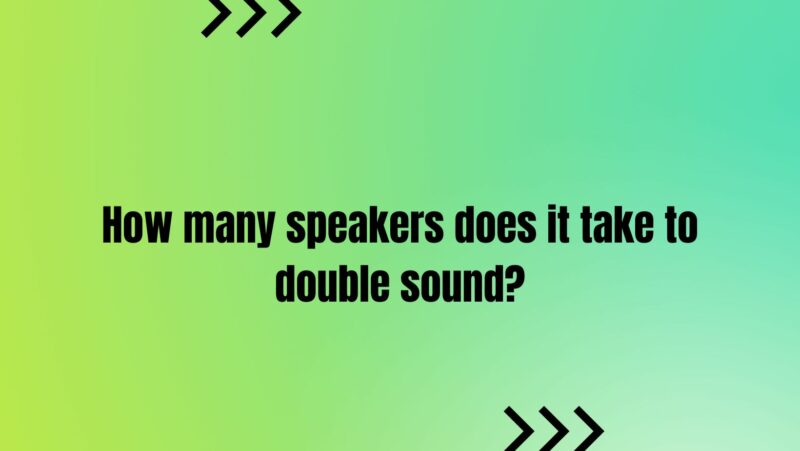In the realm of audio and sound engineering, the pursuit of enhancing auditory experiences is an ever-evolving endeavor. Among the questions that arise, one stands out: How many speakers does it take to double the sound? This exploration delves into the intricate relationship between sound waves, human auditory perception, and the factors that determine the number of speakers required to achieve a perceptible increase in volume.
I. Unveiling Perceptual Volume: Understanding Sound Intensity
Before unraveling the complexities of the question at hand, it’s crucial to establish a foundational understanding of perceptual volume. Volume, or loudness, refers to the perceived intensity of sound and is shaped by a multitude of variables, including the strength of the audio source, amplification, speaker efficiency, and the acoustic environment.
II. The Mirage of Doubling: The Volume Perception Dilemma
The notion of doubling sound appears straightforward on the surface: increasing the number of speakers by a certain factor should result in a perceived doubling of loudness. However, sound perception is far from linear; it’s governed by psychoacoustic principles that lead to a more nuanced understanding of how our auditory system interprets changes in sound intensity.
III. Psychoacoustics: The Nonlinear Nature of Perception
Psychoacoustics, the study of how humans perceive sound, reveals that our ears are sensitive to logarithmic changes in sound intensity. This means that doubling the actual sound power doesn’t lead to a perceived doubling in loudness. Instead, the increase in perceived loudness is relatively smaller due to the logarithmic relationship between intensity and perception.
IV. The Decibel Scale: Grasping Sound Measurement
The decibel (dB) scale is commonly used to quantify changes in sound intensity and loudness. A doubling of sound power translates to an increase of about 3 dB in perceived loudness. This modest increase highlights the logarithmic nature of our auditory perception and the challenge of achieving a true doubling of perceived volume.
V. The Acoustic Landscape: Room Effects
The environment in which sound is experienced plays a significant role in our perception of loudness. Room size, shape, and the presence of reflective surfaces influence sound reflections and interactions. The interaction between the number of speakers and the acoustic properties of the room contributes to how we perceive an increase in volume.
VI. The Myth of Perfect Doubling: Interference and Phase
While adding speakers might lead to an increase in volume, achieving perfect doubling is complicated by interference and phase interactions. When sound waves from different speakers combine, they can either reinforce or cancel each other out, affecting the overall perceived volume. Achieving perfect doubling requires precise control over phase relationships, which can be challenging in practice.
VII. Power Amplification: A Balancing Act
The power delivered by amplifiers to the speakers significantly influences their sound output. Adding more speakers can indeed lead to an increase in sound output, but managing the power distribution and preventing distortion is essential. Maintaining a balance between power, speaker efficiency, and the desired auditory outcome is crucial.
VIII. Enhancing Sound Coverage: Beyond Doubling
While doubling sound might not occur as straightforwardly as expected, introducing multiple speakers has other benefits. In scenarios where even sound distribution and coverage are crucial, adding speakers can help fill larger spaces and ensure that sound reaches all listeners. This is particularly relevant in public address systems and outdoor events.
IX. The Contextual Equation: Application and Goals
The impact of increasing the number of speakers on perceived volume varies depending on the context. In stereo setups, the focus might be on achieving a well-defined soundstage and imaging. In contrast, the goal in larger setups might be to ensure even coverage and audibility across the entire listening area.
X. Beyond Doubling: Elevating the Sound Experience
In conclusion, the idea of doubling sound through the addition of speakers is an oversimplification of a complex phenomenon. Our perception of loudness is influenced by psychoacoustic principles, room interactions, phase relationships, and the power distribution between speakers. Rather than chasing a perfect doubling, the true value lies in the potential to enhance sound coverage, reinforce auditory presence, and create a more immersive and engaging sonic environment.


